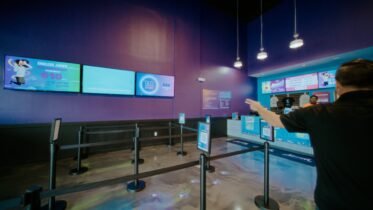From hospitals and transportation hubs to retail stores, highways, sporting events and more, digital signage continues to grow in popularity across industries and use cases, creating a market expected to grow to $23.76 billion by 2020. This adoption has been driven in part by the evolution of digital signage displays from locally managed and updated endpoints, to cloud-connected screens that update dynamically in real time. Cloud-connected digital signage provides operational efficiencies, but also creates opportunities for retailers or other organizations looking to connect with consumers and their mobile devices. Mobile integration into digital signage deployments allows displays to deliver more personalized messaging and drive more immediate action from consumers.
Increased interaction with mobility is one of many features and developments that make digital signage “dynamic, disruptive and interesting,” according to “Why 2016 Will Be The Year Of Digital Signage And Displays,” a January 2016 Forrester blog by J.P. Gownder, a VP and principal analyst for Forrester Research.
An in-depth report, “The Digital Signage And Display Opportunity In 2016,” authored by Gownder and released by Forrester in January 2016, explains how digital displays can drive valuable business scenarios across any industry, and examined their impact on the customer life cycle. The report also looked at display-to-mobile technologies and how they influence consumer behavior.
The Role of Digital Signage in Four Critical Business Scenarios
The Forrester report pointed to four critical business scenarios in which digital signage can improve the digital customer experience (DCX) and drive digital operational excellence (DOX). The scenarios include:
- Creating/reinforcing a brand. Large-screen display technology can engage passersby with a mix of interactive, branded content, “driving customer acquisition, loyalty and cross-sales.”
- Informing. Storytelling, wayfinding and other content helps a company “make information about its mission, physical layout and events omnipresent.”
- Reshaping DOX with interactivity. A magic mirror can capture images of viewers, allowing them to change their current location, background or clothing and post the results to social media. One retailer leveraging this application “doubled its number of followers while sales of key items of clothing increased by 30 percent.”
- Integrating work processes. “Digital displays can usefully integrate with work processes for employees,” the Forrester report indicates. “Samsung has implemented digital signage as an emergency alert system in schools and hospitals so staff can take appropriate actions. The result? Improved employee productivity and safety.”
The Role of Digital Signage in the Four Stages of the Customer Journey
Digital displays can play an important role across the four stages of the customer journey, according to Forrester, while improving DOX along the way. These stages include:
- Discover. Consumers in line or in a lobby can gain awareness of a category, product or brand through signage that engages them with blended content, including news, entertainment, and brand marketing and promotions.
- Explore. “In-store displays outrank manufacturers’ websites, recommendations from friends and family, and TV advertising as a primary source of product research,” reported Forrester.
- Buy. Displays can be used for digital merchandising to help drive purchases and cross-sales. A 75-inch interactive touchscreen display serves as a virtual sales assistant in Macy’s, tailored to Calvin Klein products and in-store customers, according to Forrester. The display unit knows “more about Calvin Klein products than any associate,” and customizes purchasing suggestions “on the spot.”
- Use. As customers begin to use a product or service, interactive digital signage offers in-depth demonstrations and explanations.
Mobile Integration
Since customers don’t have an app for every store, “displays can act as a bridge between customers’ physical and digital experiences, and become part of [a business’] comprehensive mobile strategy efforts,” Forrester stated. Though no universal standard exists today, “the direction is clear: Digital enterprises deploying digital signage increasingly want to link the experience to customers’ mobile phones.” For example, a sign can generate a QR code or signal that allows customers to take the information with them on their own phones.
The next step for interactive digital signage is the ability for signage to communicate with consumers’ mobile devices, according to a white paper from Digital Signage Today. The display technology will “either recognize the consumer and display content based on some predetermined parameters or … push content, such as coupons or other sale information, to the consumer’s phone.”
The growing connection between digital signage and mobile devices is significant, particularly as smartphones become increasingly ubiquitous. According to Gartner, 1.4 billion smartphones were sold in 2015 alone. As mobile adoption grows, the prospects for digital signage will only expand.
Learn more about Samsung digital signage solutions and how to incorporate them into your business.








